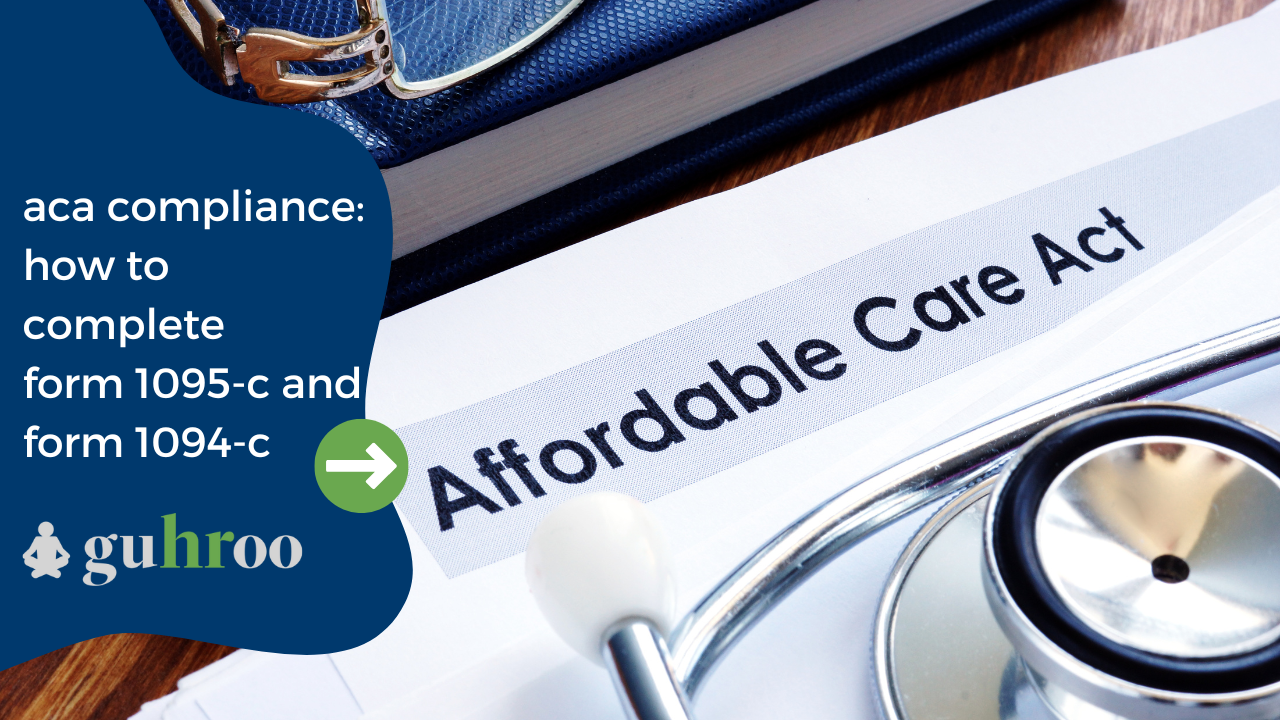I hosted a webinar a few weeks back called “How to Complete Form 1095-C and Form 1094-C” and I asked all of the participants to tell me what their number one concern was with the Affordable Care Act. One of the participants (you know who you are) gave me this gem:
“I have 5,000 concerns about the ACA, it
would be unfair to the other 4,999 to list one first.”
 While that is funny, this is a topic that gives a lot of people heartburn. In a recent survey, nearly 50% of executives of companies with more than 50 employees stated they are not adequately prepared for the new reporting regulations.
While that is funny, this is a topic that gives a lot of people heartburn. In a recent survey, nearly 50% of executives of companies with more than 50 employees stated they are not adequately prepared for the new reporting regulations.
At guHRoo (formerly ERG), we are all about making things simple. Below is a simple breakdown of how to complete the 1095-C and 1094-C forms along with a few “Frequently Asked Questions.” You can also watch the recording of the webinar where I walk you through these forms line-by-line.
If you have questions about whether you need to complete these reports, how to deal with seasonal employees, or the Employer Mandate in general, this guide is where you will find all of that info.
The information below, combined with this guide to completing the forms, and this video will give you everything you need to prepare and complete forms 1095-C and 1094-C. These resources will give you everything you need to complete the forms.
Disclaimer: I have no opinion or political team when it comes to the ACA, I just deal with the facts.
What is this reporting all about?
The Employer Mandate provision of the Affordable Care Act requires all employers with 50 or more full time equivalent employees (FTE) to offer a certain level of health insurance coverage at an affordable rate to all FTE’s or face a penalty. I am going to share tips specifically for the year end reporting component of this provision, covered under Section 6056, the 1094-C and 1095-C reporting.
Who is Required to Complete the 1094-C and 1095-C?
Applicable Large Employers, generally employers with 50 or more full-time employees (including full-time equivalent employees) in the previous year, must file one or more Form 1094-C and must file a Form 1095-C for each employee who was a full-time employee of the employer for any month of the calendar year. Generally, the employer is required to furnish a copy of the Form 1095-C to the employee.
The best way to think about these forms is the 1094-C is like a W3 (company info) and the 1095-C is like a W2 (employee info). As a reminder, you have to get an additional electronic consent from the employee if you are providing an electronic copy of the 1095-C, the same way you do for the W2.
Transitional Relief for 2015
There is a little bit of Transitional Relief for calendar year 2015 if you fall into one of the following situations:
50-99 FTE’s: There are no penalties for calendar year 2015 reporting if you have between 50 and 99 FTE’s; however, in order to qualify for relief, you must make a good faith effort to accurately report. You also must not have reduced your number of employees to fall into this category.
Offers of Minimum Essential Coverage to at Least 70% of FTE’s: For each calendar month during 2015 an employer has to offer MEC to at least 70 percent of its full-time employees (and their dependents). This requirement will increase to 95% in 2016.
Penalties Start at 80 FTE’s Instead of 30: If you are choosing to “pay” instead of “play,” or you are non-compliant, the penalties will start at 80 FTE’s instead of 30. You can read more about that in the Navigating the Employer Mandate Guide.
Relief Under the Qualifying Offer Method: For 2015 only, if the employer made a qualifying offer to at least 95% of all full-time employees and allowed family members to enroll in the plan (regardless of the cost to employees of family member coverage), the employer will be permitted to use this qualifying offer simple reporting method for all employees, including those who did not receiving a qualifying offer for the entire year.
These are not all of the transitional relief available, but they are the most common. You can read all of the relief methods here.
How to Complete Form 1095-C
Alright, let’s take a look at the 1095-C. The employee form. This is similar to the W2 in that you will issue it to the employees, but you don’t need to issue it to part-time employees, only FTE’s. Below are a few quick tips that will help you to accurately complete these forms. You can also get our handy cheat sheet for proper codes here.
Part I
 In part one you will fill out the employee name, SSN (including the dashes), and address. Make sure the employee address goes in 1-6. Employer info goes in lines 7-13. This needs to match the 1094-C information.
In part one you will fill out the employee name, SSN (including the dashes), and address. Make sure the employee address goes in 1-6. Employer info goes in lines 7-13. This needs to match the 1094-C information.
In line 7 it is asking for the legal entity that employs the particular person you are submitting the 1095-C for. If you have three legal entities in your business, just use the one that employs this person.
Line 9 seems simple enough, but when you have corporate structures and multiple addresses, this can get confusing. You can either put the address of the branch, location, or site, or you could put the corporate HQ. Whichever address you choose, it still has to match the 1094-C (once again, think W3 and W2).
Line 10, I recommend you put the telephone number of someone that can promptly reply to any employee inquiry.
Part II
In part two, this is where things get more interesting. I receive questions daily about completing these forms and 95% of them have to deal with lines 14, 15, and 16.
The Plan Start Month may be left blank for tax year 2015 reported in 2016. This was here to accommodate the 2014 tax year. This box is optional for the 2015 Form 1095-C and the employer may leave it blank; it is anticipated that this box will be mandatory for the 2016 Form 1095-C.
Line 14: What, if any medical benefit did you offer the employee? Line 14 only cares about what you offered an employee. Line 14 does not care about your excuses. Line 16 cares about your excuses. You will want to fill in the applicable code for each employee.
Line 14 gets tricky pretty fast because you can’t just write in whatever your health plan is. Instead you have to review a series of codes and identify where you fall as an employer, where the individual recipient falls, and where the medical benefits fall. These codes can be found (and simplified) in this guide.
Once you familiarize yourself with the codes that apply to your company, it will get fairly simple. Most companies will not use more than two codes unless they make major changes to their plans. You can review the codes based on your situation for line 14 in the handy guide.
Once you know the codes, you need to input how long the employee had that particular offer. If they had the offer all year, just add the code to the all 12 months box. If less, add the appropriate code to the appropriate months.
You must enter 1H for any months the employee was not offered coverage by you. This includes months that they were not employed by you.
- Q: Does someone in a lawful waiting period qualify as having been offered insurance during a month in which the employee was in a waiting period?
- Answer: NO. Someone in a waiting period did not get an offer of coverage. The reason is irrelevant on line 14.
Line 15: How much did that medical benefit cost the employee if you are claiming it was a qualified health plan? If you use codes 1B, 1C, 1D, or 1E, either in the All 12 Months box or in any of the 12 months, you need to fill this out.
If you enter 1A or 1I in line 14, you must leave 15 blank. If you entered 1G on Line 14, you also do not have to fill out Line 15 or 16 for those months in which you used that code.
Line 15 is asking you to report the employee share of the monthly premium for the lowest cost, self-only minimum value coverage. Line 15 does not care about families or dependents, it is only asking about the self-only employee coverage cost. Line 15 only cares about the lowest cost plan. If you are offering a Gold, Silver, and a Bronze, line 15 only cares about the Bronze. The lowest plan you offer, price to the employee, for self-only coverage.
Line 16: What did the employee do when you offered him or her medical benefits OR what excuse did you have for not offering the employee medical benefits?
On line 16, you will enter the applicable code for one or more months that the following occurred, you can get the codes from this guide.
Sometimes no code will apply here and it is better to leave it blank then put something that is wrong and get audited.
If you buy your insurance from a carrier, you are done!!
Now you just need to do this for every employee. If you are self-insured, you need to fill out Part 3 for all covered individuals.
Part III
In part three, you will complete this section only if you provide employer sponsored coverage or self insured plans.
How to Complete Form 1094-C
Now let’s take a look at Form 1094-C. The 1094-C is very similar to the W3, you will submit one for the entire company.
Part I
The top half of the 1094-C form is fairly straightforward, but I will hit a few key points.
Make sure that on line one you are entering the information for the entity which you are reporting. If you have multiple, you need to submit multiple forms and designate one as the “authoritative transmittal” on line 19.
On line 18, you are completing the number of 1095-C forms with this transmittal. That means that if you have multiple transmittals, you are only putting the number for this transmittal.
This first box on the bottom, number 19, identifies if the form is the Authoritative Transmittal, you will likely be checking this unless you have special circumstances. For example, if an employer intends to file a separate Form 1094-C for each of its two divisions to transmit Forms 1095-C for each division’s full-time employees, one of the Forms 1094-C filed must be designated as the Authoritative Transmittal and report aggregate employer-level data for both divisions, as required in Parts II, III, and IV of Form 1094-C.
Part II
Line 20 is the total number of 1095-C forms that are being filed with this form. This includes any 1095-C’s that are being filed on behalf of the employer.
Line 21, check YES if on any month of the previous calendar year, you were a member of an aggregated ALE, if you check NO, don’t complete part 4.
Line 22 gets a little more complicated.
If you fill out the form regularly, this is called the General Method. If you meet the eligibility requirements for one of the alternate methods; the Qualifying Offer, 98% Offer, or one of the applicable relief methods, you will need to check the appropriate box.
Box A: Qualifying Offer Method- An employer may take advantage of this option if it provides a “qualifying offer” of insurance to any of its full time employees. A qualifying offer is an offer of a bronze level or higher plan where the cost to the employee of employee-only coverage is less than about $1,100 in 2015 (9.5 percent of the Federal Poverty Level). Also, the employer must offer the plan to all members of the employee’s family to be eligible to use this reporting method.
Box B: Qualifying Offer Transition Relief- For 2015 only, if the employer made a qualifying offer to at least 95% of all full-time employees and allowed family members to enroll in the plan (regardless of the cost to employees of family member coverage), the employer will be permitted to use this qualifying offer simple reporting method for all employees, including those who did not receiving a qualifying offer for the entire year.
If you use this method, you must not report Part 2, line 15 for any month in which a qualifying offer is made, or for which the qualifying offer met the transition relief applies.
An employer that reports using this method must report 1A or 1I. You are not required to use this method even if you are eligible.
Box C: Section 4980H Transition Relief- You will want to check this box if you are eligible for 4980H transition relief. We discussed the Transitional Relief categories above and you can find more information about them here.
Eligibility for this transition relief is reported on Form 1094-C, line 22, box C, and the specific form of relief for which the employer is eligible must be reported on Form 1094-C, Lines 23-35, column (e), using either code A (50-99 Transition Relief) or code B (100 or more Transition Relief). An employer eligible for this relief is still subject to the Forms 1094-C and 1095-C reporting requirements for 2015 with respect to its full-time employees.
Please keep in mind if you are using a simplified reporting method, you will still need to keep detailed records to provide in case of an audit.
Box D: 98% Offer Method- To provide even greater reporting relief to reward employers offering to at least 98% of the company’s full time employees a bronze level or higher plan at an “affordable” rate, the IRS is offering the 98% Offer Method.
So how is the reporting different when using this method?
The employer is not required to identify which employees regularly work full-time hours. Rather, the employer is simply required to include in the report those employees who may be full-time.
Part III
Part three is where you will indicate if Minimum Essential Coverage was provided and for how long. If you offer MEC to at least 95% of FTE’s and their dependents for all 12 months you can check YES on line 23 for All 12 Months.
If you offered MEC to at least 95% for employees and their dependents you should enter for the applicable months. For the months you did not offer, enter X in the NO checkbox. If you did not offer MEC for 95% of FTE’s enter X in the NO checkbox. However, if you did not offer MEC and were eligible for Transition Relief, you can enter a yes for line 23 column A. See IRS instruction if this applies to you.
In column B, you enter the number of FTE’s for each calendar month. You must use the same day for each month of the year. You can use the first day, last day, or the first or last day of the payroll period of each month. You have to use one of these four. If the number is the same for every month, enter the same number in every box. If you checked YES in line 21, you will need to complete column B, if you are a member of an ALE for all 12 months, check ALL 12 months. If not, check an X for all months.
If you enter yes for one or more months, you will need to complete part four, but before we get to that, if you selected box C on line 22, you will need to add the code here.
Almost done with 1094-c. On the last page you will need to complete section four if you selected YES on line 21.
YOU’RE DONE! Go get a glass of wine. Now let’s look at a few of the frequently asked questions and deadlines you need to be aware of.
FAQ’s:
- Q: Do I have to provide a 1095-C to all FTE’s I offered coverage to during the calendar year?
- A: Yes, all FTE’s. Think W2. Any employees who were FT at any point during the year need to receive the form. This applies whether they were employed the whole year or not.
- Q: Do companies have to offer coverage to spouses?
- A: No, there is no requirement to offer coverage to spouses, but there is a requirement to offer coverage to dependents up to 26 years old.
- Q: If I have less than 100 FTE’s do I need to complete the 1094-C for 2015?
- A: Yes, all ALE’s with more than 50 FTE’s are required to report in early 2016 for 2015. Even though you are being given a pass on compliance, you still have to report and use the appropriate transition relief code.
Deadlines:
January 31, 2016
Employee Must Receive 1095-C
Form 1095-C may be sent electronically like the W2 if the IRS electronic distribution requirements are met, but the employer must receive consent from the employee separate from the W2.
All of the 1095-C forms must be submitted with the 1094-C.
If you are filing over 250 1095-C forms, you are required to file electronically.
February 28th, 2016
Paper Form 1094-C are due
March 31st, 2016
Electronic submissions of Form 1094-C are due
Are you tired? I am tired. That was a long trip. While this might be the most boring post I have ever written (some would argue that), I hope you find it to be useful.
There are over 20,000 pages of legislation surrounding the Affordable Care Act and it is projected that there will be another 20,000 pages by 2020. We aim to boil this information down to the “need to know” information for you. Completing the 1094-C and 1095-C forms will be a challenge for all ALE’s, but hopefully these tools will help you to complete the forms and maintain compliance.
For those of you that are not familiar with guHRoo (formerly ERG), we provide payroll and HR support services for small to mid-sized businesses around the country. We are headquartered in Columbia, SC and can serve all 50 states to help you maintain compliance with the ACA and all other HR related matters. We can automatically complete these forms for you if you use our payroll services or human resources information system.
This is not legal advice. This is a complex subject. If I missed anything above, please let me know and I will update accordingly. Thanks!




